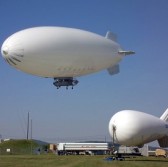 Raytheon has finished testing an aerostat radar platform the company designed to help the U.S. Army track missile and aircraft threats as far as 340 miles away.
Raytheon has finished testing an aerostat radar platform the company designed to help the U.S. Army track missile and aircraft threats as far as 340 miles away.
The Joint Land Attack Cruise Missile Defense Elevated Netted Sensor system consists of two helium-filled blimps that are built to fly at 10,000 feet to identify targets and provide Army personnel with a 360-degree surveillance coverage, Raytheon said Monday.
Dave Gulla, Raytheon vice president for the global integrated sensors group, said the company performed lab tests to assess whether JLENS could integrate with the North American Aerospace Defense Command infrastructure.
“With JLENS providing data to NORAD, our military will have a more accurate picture of what is flying in the National Capital Region’s airspace, and be able to identify slow-and-low flying threats such as cruise missiles and drones,” Gulla added.
The Army is scheduled to deploy one JLENS system over Aberdeen Proving Grounds in Maryland later this year and would fly a second JLENS when any of its combatant units worldwide request a need for the technology.




